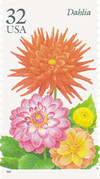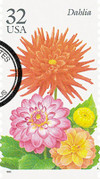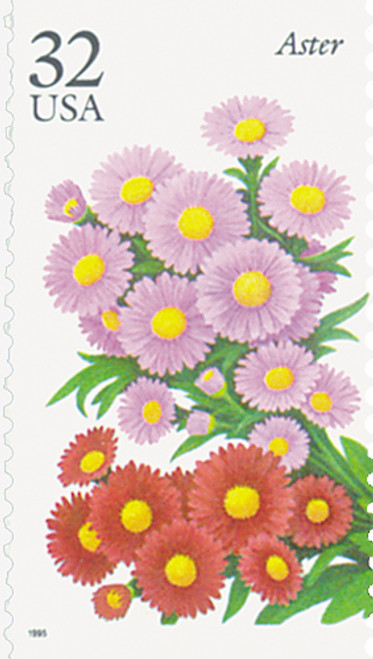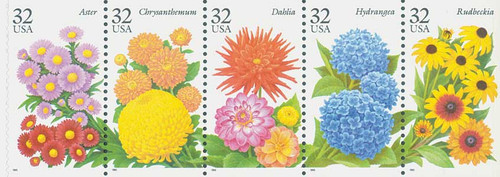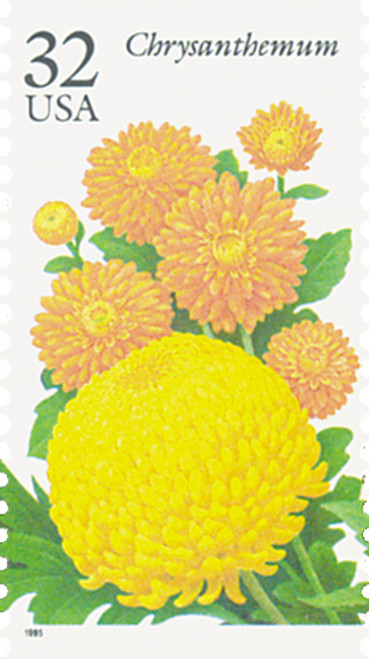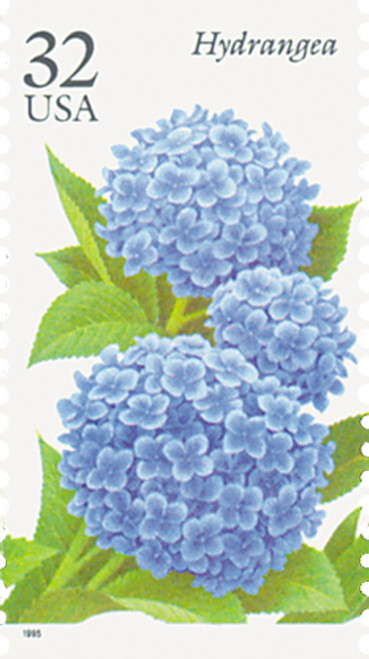
# 2995 - 1995 32c Fall Garden Flowers: Dahlia
U.S. #2995
1995 Dahlia
Fall Garden Flowers
- Third issue in the Garden Flowers Series
Stamp Category: Commemorative
Series: Garden Flowers
Value: 32¢ First-Class postage rate
First Day of Issue: September 19, 1995
First Day City(s): Encinitas, California
Quantity Issued (if known): 200,000,000
Printed by: Bureau of Printing and Engraving
Printing Method: Offset (flower images) Intaglio (type)
Format: Booklet of 20 stamps. Four booklet panes of 5 stamp strips.
Perforations: 10.9
Why this stamp was issued: This stamp was issued as part of the third installment of the Garden Flower Series. This stamp fulfilled the then-current first-class postage rate of 32¢.
First Day City: The ceremony was held at the Quail Botanical Gardens in Encinitas, California.
About the Garden Flowers Series: On May 15, 1993, the USPS issued the first installment in the Garden Flower Series, which would honor flowers that bloom in each of the four seasons.
This series was born out of the 1992 Wildflowers issue. That project had begun when the USPS asked an artist to produce color sketches of a group of garden flowers. Instead, the artist gave the USPS illustrations of wildflowers. The USPS liked them so much, it decided to create a 50-stamp pane, showing wildflowers that can be found in each state.
The USPS still liked the garden flowers idea. Part of the push behind these stamps had come from the sale of stamps in supermarkets and other retailers. People said they wanted “bright, pretty American stamps.” The USPS decided flower booklets would please the public. It ran TV commercials and full-page advertisements in stamp publications announcing “The flowers are in bloom at your post office. Buy them while they last!” and “Pick up a bunch.” The Garden Flowers booklet was the first to be produced on the new Goebel booklet machine, which was the first to print multicolor covers.
The stamps were issued on May 15, 1993, in Spokane, Washington at the 55th annual Spokane Lilac Festival and International Lilac Society Convention. Though not announced at the time, these stamps were to be the first in a new series of seasonal flower booklets.
The second booklet in the series was issued on April 28, 1994, at the Greater Cincinnati, Ohio, Flower and Garden Show. It featured summer garden flowers.
The third booklet in the series was issued on September 19, 1995, at the Quail Botanical Gardens in Encinitas, California. This booklet featured fall blooms.
The final booklet in the series was issued on January 19, 1996, in Kennett Square, Pennsylvania. The flowers selected for these stamps are the hardiest plants that grow anywhere in the country that experiences winter weather.
History the stamp represents:
Dahlia
The dahlia shows how plants were dispersed worldwide during the age of exploration. Naturalist Francisco Hernandez sent some native Mexican flowers to Philip II of Spain. Captivated by the blood-red beauties, the king decreed them a Spanish possession, forbidding their removal from the royal gardens. But the living treasure could not be hoarded. Soon, dahlias appeared throughout Europe. They were named in honor of Andreas Dahl, pupil of Linneaus, originator of the scientific classification system.
Europe entered a dahlia craze. In 1838 a single plant was exchanged for a rare diamond; later, a £1,000 prize was offered for a blue dahlia. Fifty years after the dahlia’s arrival, over 2,000 hybrids had been developed from the single Mexican species. Besides adorning gardens, dahlia tubers were used for medicinal purposes. High in fructose, they helped in the treatment of diabetes, as well as kidney and liver diseases.
The dahlia (cocoxochitl) was sacred to the Aztecs. This blood-red flower symbolized the mother of their war god. Because the blooms had eight petals, human sacrifice to the god occurred every eight years. Ironically, another legend associated the cocoxochitl with Quetzalcoatl, the Aztec god of peace.
U.S. #2995
1995 Dahlia
Fall Garden Flowers
- Third issue in the Garden Flowers Series
Stamp Category: Commemorative
Series: Garden Flowers
Value: 32¢ First-Class postage rate
First Day of Issue: September 19, 1995
First Day City(s): Encinitas, California
Quantity Issued (if known): 200,000,000
Printed by: Bureau of Printing and Engraving
Printing Method: Offset (flower images) Intaglio (type)
Format: Booklet of 20 stamps. Four booklet panes of 5 stamp strips.
Perforations: 10.9
Why this stamp was issued: This stamp was issued as part of the third installment of the Garden Flower Series. This stamp fulfilled the then-current first-class postage rate of 32¢.
First Day City: The ceremony was held at the Quail Botanical Gardens in Encinitas, California.
About the Garden Flowers Series: On May 15, 1993, the USPS issued the first installment in the Garden Flower Series, which would honor flowers that bloom in each of the four seasons.
This series was born out of the 1992 Wildflowers issue. That project had begun when the USPS asked an artist to produce color sketches of a group of garden flowers. Instead, the artist gave the USPS illustrations of wildflowers. The USPS liked them so much, it decided to create a 50-stamp pane, showing wildflowers that can be found in each state.
The USPS still liked the garden flowers idea. Part of the push behind these stamps had come from the sale of stamps in supermarkets and other retailers. People said they wanted “bright, pretty American stamps.” The USPS decided flower booklets would please the public. It ran TV commercials and full-page advertisements in stamp publications announcing “The flowers are in bloom at your post office. Buy them while they last!” and “Pick up a bunch.” The Garden Flowers booklet was the first to be produced on the new Goebel booklet machine, which was the first to print multicolor covers.
The stamps were issued on May 15, 1993, in Spokane, Washington at the 55th annual Spokane Lilac Festival and International Lilac Society Convention. Though not announced at the time, these stamps were to be the first in a new series of seasonal flower booklets.
The second booklet in the series was issued on April 28, 1994, at the Greater Cincinnati, Ohio, Flower and Garden Show. It featured summer garden flowers.
The third booklet in the series was issued on September 19, 1995, at the Quail Botanical Gardens in Encinitas, California. This booklet featured fall blooms.
The final booklet in the series was issued on January 19, 1996, in Kennett Square, Pennsylvania. The flowers selected for these stamps are the hardiest plants that grow anywhere in the country that experiences winter weather.
History the stamp represents:
Dahlia
The dahlia shows how plants were dispersed worldwide during the age of exploration. Naturalist Francisco Hernandez sent some native Mexican flowers to Philip II of Spain. Captivated by the blood-red beauties, the king decreed them a Spanish possession, forbidding their removal from the royal gardens. But the living treasure could not be hoarded. Soon, dahlias appeared throughout Europe. They were named in honor of Andreas Dahl, pupil of Linneaus, originator of the scientific classification system.
Europe entered a dahlia craze. In 1838 a single plant was exchanged for a rare diamond; later, a £1,000 prize was offered for a blue dahlia. Fifty years after the dahlia’s arrival, over 2,000 hybrids had been developed from the single Mexican species. Besides adorning gardens, dahlia tubers were used for medicinal purposes. High in fructose, they helped in the treatment of diabetes, as well as kidney and liver diseases.
The dahlia (cocoxochitl) was sacred to the Aztecs. This blood-red flower symbolized the mother of their war god. Because the blooms had eight petals, human sacrifice to the god occurred every eight years. Ironically, another legend associated the cocoxochitl with Quetzalcoatl, the Aztec god of peace.







